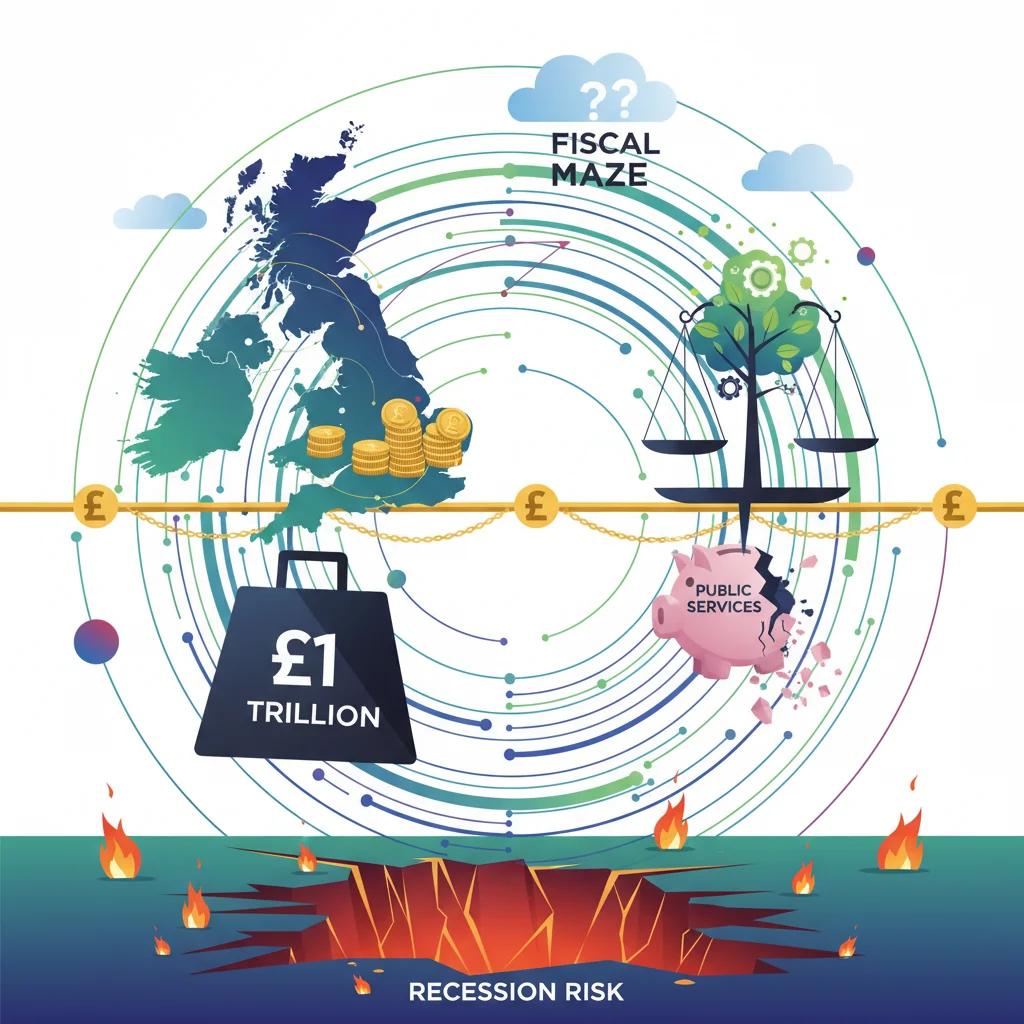
The UK’s Trillion-Pound Tightrope: Can Britain Balance the Books Without Breaking the Economy?
The Unenviable Choice: Navigating the UK’s Post-Pandemic Fiscal Maze
In the world of national economics, there are difficult choices, and then there is the position of the UK Chancellor of the Exchequer. The United Kingdom stands at a precarious fiscal crossroads, caught in a seemingly impossible bind between soaring public debt, crumbling public services, and immense political pressure for tax cuts. The fundamental question, as highlighted in a recent analysis by the Financial Times, is no longer just a matter of balancing a spreadsheet; it’s about charting a course for the nation’s economic future. How can the government reconcile the need for robust public spending with the demand for a lower tax burden, all while keeping the bond markets calm and investors confident?
This isn’t just a political headache; it’s a multi-trillion-pound challenge with profound implications for every citizen, investor, and business leader. The decisions made in the coming months will ripple through the UK economy, influencing everything from the value of the pound and the performance of the stock market to the cost of your mortgage and the quality of public infrastructure. Understanding this dilemma is crucial for anyone involved in finance, investing, or simply planning for the future.
Anatomy of a Crisis: The Three-Front War on the UK’s Finances
To grasp the severity of the situation, we must dissect the three primary pressures squeezing the UK’s public purse. These forces are not independent; they feed into a vicious cycle that makes any easy solution politically and economically treacherous.
1. The Mountain of Debt and the Spectre of Interest Rates
The combined impact of the 2008 financial crisis, the COVID-19 pandemic, and the recent energy crisis has left the UK with a national debt hovering near 100% of GDP. This is a level not seen since the 1960s. For years, low interest rates made this debt manageable. However, as central banks, including the Bank of England, have hiked rates to combat inflation, the cost of servicing this debt has skyrocketed. Billions of pounds that could be spent on hospitals or schools are now being diverted to pay interest to bondholders. This creates a rigid constraint on any new spending or tax cuts, as any move perceived as fiscally irresponsible could trigger a sell-off in UK government bonds (gilts), pushing borrowing costs even higher—a painful lesson learned during the brief but chaotic “mini-budget” of late 2022.
2. The Silent Squeeze: Deteriorating Public Services
While the debt figures dominate headlines, the tangible reality for many Britons is the visible decline in public services. The National Health Service (NHS) is grappling with record waiting lists, schools are struggling with strained budgets, and local councils are facing bankruptcy. Decades of underinvestment, combined with recent inflationary pressures, have created a critical situation. The public appetite for further austerity is virtually non-existent. In fact, there is widespread demand for *more* government spending to fix these deep-seated problems. This presents a direct conflict with the goal of fiscal consolidation, as improving services requires significant investment—money the government simply doesn’t have without raising taxes or cutting elsewhere (source).
3. The Political Promise of Tax Cuts
In the political arena, cutting taxes is often seen as a silver bullet for stimulating economic growth and winning votes. The current government faces immense pressure to lower the tax burden, which has risen to its highest level in 70 years, partly due to a phenomenon known as “fiscal drag.” This occurs when tax thresholds are frozen while wages rise with inflation, silently pulling more people into higher tax brackets. While tax cuts could boost disposable income and encourage private sector investing, they come at a direct cost to the Treasury’s revenue. In the current climate, any significant unfunded tax cut would be viewed by financial markets as a reckless gamble, risking a repeat of market turmoil.
Charting the Treacherous Path Forward: Three Potential Scenarios
The government is essentially faced with three broad, and equally unappealing, strategic paths. Each carries its own set of economic consequences and political risks. Below is a simplified breakdown of these options.
| Policy Path | Key Actions | Potential Economic Impact | Risk to Investor Confidence |
|---|---|---|---|
| Path 1: Renewed Austerity | Deep, real-term cuts to public spending in unprotected departments (e.g., justice, local government). Delaying capital projects. | Reduces deficit but risks choking off economic recovery. Worsens public service quality, potentially leading to social unrest and lower long-term productivity. | Low-to-Medium. Markets may appreciate the fiscal discipline, but fear the lack of a growth strategy. |
| Path 2: The Tax-and-Spend Model | Cancel planned tax cuts. Introduce new taxes (e.g., wealth tax, windfall taxes) or increase existing ones (e.g., VAT, corporation tax). | Provides funding for public services and debt reduction. Risks stifling business investment and reducing consumer spending, potentially making the UK less competitive. | Medium. Depends on the nature of the taxes. Predictable, broad-based taxes may be accepted, but anti-business levies could spook investors. |
| Path 3: The “Growth” Gamble | Implement significant, unfunded tax cuts with the hope of stimulating rapid economic growth that eventually pays for the cuts. Aggressive deregulation. | High-risk, high-reward. A “dash for growth” could, in theory, break the cycle. However, it’s more likely to be seen as fiscally irresponsible, as recent history has shown (source). | Very High. A repeat of the 2022 mini-budget could cause a gilt market crisis, a run on the pound, and a severe loss of international credibility. |
What This Means for You: Implications for Investors, Businesses, and the Tech Sector
This high-level fiscal drama has very real-world consequences. Navigating this environment requires a nuanced understanding of the potential impacts across different sectors.
For Investors and Traders
Uncertainty is the enemy of stable markets. The current fiscal bind creates significant volatility for UK assets.
- UK Stock Market (FTSE): Domestically focused companies are highly sensitive to the health of the UK consumer and government spending. A path of austerity could hurt retailers and construction firms, while higher taxes could squeeze corporate profits across the board. International FTSE 100 giants are more insulated but still affected by the value of the pound.
- Currency (GBP): Sterling’s value is a direct reflection of international confidence in the UK economy. Any perceived fiscal recklessness will likely lead to a weaker pound, importing inflation and hurting those with foreign assets.
- Gilt Market: The market for UK government debt is the ultimate arbiter. Investors will demand higher yields (leading to higher borrowing costs for the government and, by extension, consumers) if they believe the UK’s debt path is unsustainable. Active trading in these markets will be heavily influenced by budget announcements.
The key takeaway for investors is the need for diversification and a cautious approach to UK-centric assets until a clear and credible fiscal plan emerges.
For Business Leaders
For businesses, the primary concerns are stability, clarity on the tax regime, and the health of the domestic market. A government lurching between austerity and unfunded tax cuts creates an unpredictable environment that chills investment. Businesses need to plan for several scenarios: higher corporate taxes, reduced consumer demand due to a squeezed middle class, and potential cuts to infrastructure projects that could impact supply chains and growth opportunities.
The Role of Financial Technology (Fintech)
In this challenging environment, the UK’s world-leading fintech sector could play a dual role. On one hand, the sector is vulnerable to shifts in investment appetite and regulatory uncertainty. On the other, financial technology offers tools for resilience and efficiency.
- For Government: Advanced data analytics and even distributed ledger technologies like blockchain could offer new ways to improve the efficiency and transparency of public spending, ensuring taxpayer money is used more effectively.
- For Businesses and Investors: Fintech platforms provide sophisticated tools for managing risk, accessing diverse investment opportunities, and optimizing cash flow in a tough economic climate. The growth of digital banking and automated trading platforms empowers individuals and SMEs to be more agile.
The government’s fiscal choices will send a strong signal about whether the UK intends to remain a premier global hub for innovation in finance.
Conclusion: No Easy Answers on the Road Ahead
The UK’s “budget blues” are more than a temporary ailment; they are a symptom of deep structural challenges that have been years in the making. There is no magic wand to wave that can simultaneously fund world-class public services, cut taxes, and rapidly pay down a mountain of debt. The path forward will require honest trade-offs and a long-term vision that extends beyond the next election cycle.
For those watching from the sidelines—be it from a trading floor, a boardroom, or a home office—the message is clear: the era of easy money and fiscal ambiguity is over. The decisions made next will determine the trajectory of the UK economy for the next decade. Success will be defined not by bold, popular promises, but by the quiet implementation of a credible, sustainable, and realistic plan to finally balance the nation’s books.


